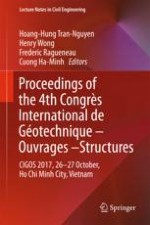This proceedings volume for the 4th international conference CIGOS 2017 (Congrès International de Géotechnique - Ouvrages - Structures) presents novel technologies, solutions and research advances, making it an excellent guide in civil engineering for researchers, students, and professional engineers alike.
Since 2010, CIGOS has become a vital forum for international scientific exchange on civil engineering. It aims to promote beneficial economic partnerships and technology exchanges between enterprises, worldwide institutions and universities. Following the success of the last three CIGOS conferences (2010, 2013 and 2015), the 4th conference was held at Ho Chi Minh City University of Technology, Ho Chi Minh City (Saigon), Vietnam on 26 to 27 October 2017. The main scientific themes of CIGOS 2017 were focused on ‘New Challenges in Civil Engineering’.
